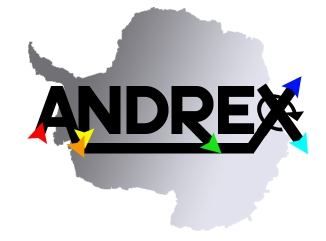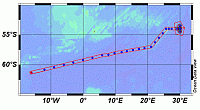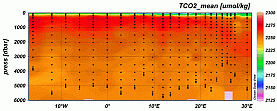Natural and Anthropogenic Carbon Transport & Storage
Rationale
The Southern Ocean is a key area for ventilation of the deep waters of the global oceans. The Weddell Gyre is a large elongated clockwise rotating gyre, south of the Antarctic Circumpolar Current (ACC). Deep water, rich in ‘natural’ CO2, reaches the surface in the Weddell Gyre. Major quantities of dense deep and bottom water are produced near and on the Antarctic continental shelves, which are likely to be accompanied by uptake of ‘anthropogenic’ CO2. In the western Weddell Gyre the largest share of dense waters is produced. Part of this water leaves the gyre circulation through deep passages in the northern boundary of the gyre, while another part is transferred to the eastern gyre. In the eastern Weddell Gyre major interaction takes place with the ACC (Gouretski and Danilov, 1993). The north-eastern gyre region is important from a biogeochemical point of view and might be a significant CO2 sink (Hoppema et al., 2000; Bakker et al., 2008). The ANDREX cruise track along the northern boundary of the Weddell Gyre repeats a previous realisation in the north-eastern gyre (ANT 13/4 in 1996).
Carbon Objectives
1. Quantification of the carbon budget for the Weddell Gyre
2. Determination of anthropogenic CO2 along the northern boundary of the Weddell Gyre
3. Comparison with earlier carbon data and determination of interannual variability along the eastern part of the section (ANT 13/4 in 1996)
4. Assessment of CO2 air-sea transfer in the Weddell Gyre, particularly north-eastern part
5. Investigation of processes and mechanisms leading to the summertime CO2 sink of the north-eastern Weddell Gyre.
Methods
Two ANDREX cruises are scheduled for December 2008 to January 2009 (east, JC31) and March to April 2010 (west, JR239). Underway measurements of the partial pressure of CO2 (pCO2) in surface water and marine air are made, as well as vertical profiles of DIC (dissolved inorganic carbon) and alkalinity at CTD stations. The carbonate parameters will be submitted to the international database at CDIAC (Carbon Dioxide Information Analysis Center) and the British Oceanographic Data Centre
Initial results for the eastern ANDREX section are in Figure 2. Low DIC in the surface waters is presumably caused by a combination of dilution by melt water and biological carbon uptake (Bakker et al., 2008). The DIC maximum at 200 to 1000 m depth reflects the presence of Circumpolar Deep Water (CDW) or Warm Deep Water (WDW). Relatively low DIC northeast of 57°S 20°E indicates ACC influence. The DIC concentration gradually decreases below the WDW.
Contributors
Dorothee C.E. Bakker (1), Mario Hoppema (2), Pete Brown (1,3), Elizabeth Jones (1), Maciej Telszewski (1), Steven Jones (1) and Shaun Scally (1)
(1) School of Environmental Sciences, University of East Anglia, Norwich, UK
(2) Alfred Wegener Institute for Polar and Marine Research, Bremerhaven, Germany
(3) British Antarctic Survey, Cambridge, UK
References
Bakker, D.C.E., M. Hoppema, M. Schröder, W. Geibert, H.J.W. de Baar (2008) A rapid transition from ice covered CO2-rich waters to a biologically mediated CO2 sink in the eastern Weddell Gyre. Biogeosciences 5, 1373-1386.
Gouretski, V.V., A.I. Danilov (1993) Weddell Gyre: Structure of the eastern boundary. Deep-Sea Research I 40, 561-582, 1993.
Hoppema, M., M.H.C. Stoll, H.J.W. de Baar (2000) CO2 in the Weddell Gyre and Antarctic Circumpolar Current: Austral autumn and early winter. Marine Chemistry 72, 203-220.
Schlitzer, R., 2009. Ocean Data View, http://odv.awi.de.











